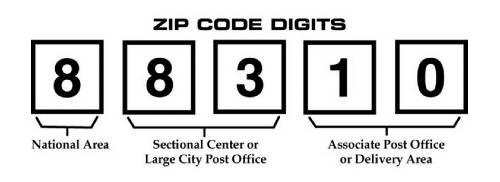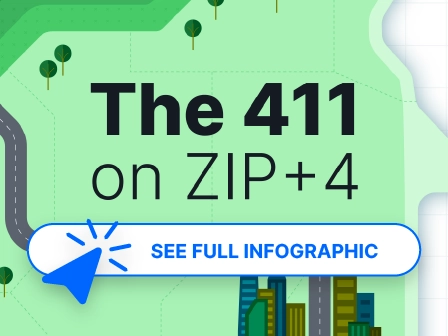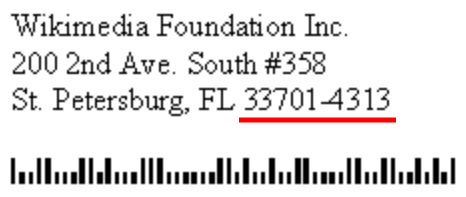ZIP+4 Code lookup, get the last 4 digits of 9-digit ZIP codes
| Single ZIP+4 Code lookup | Bulk ZIP+4 Code lookup | Zip+4 Code lookup API |
|---|---|---|
| Try It Now | Try It Now | Try It Now |

A ZIP+4 Code is a 4-digit code appended to a standard 5-digit ZIP that helps the USPS sort, route, and deliver mail more efficiently. The last 4 digits of these 9-digit ZIP Codes usually represent 6-20 delivery points on a USPS carrier route.
Did we put you to sleep yet? Yeah, we thought so. ZIP Code information can be incredibly dry, but knowing its inner workings will help to clarify the super secret awesome sauce that they bring to the address table.
Stick with us to learn how ZIP Plus 4 Codes help to prevent misdelivered, lost, delayed, and returned mail. Including those last 4 digits of the ZIP Code can reduce delivery time by as much as 2 days. We’ll try to add the sauce to keep the article from being too dry.
Full 9-digit ZIP Code lookup
Also called plus-four codes, 9-digit ZIP Codes, and full ZIP Codes, USPS ZIP+4 Codes can be looked up using various tools.
Smarty provides some easy-to-use options for single ZIP+4 Code lookups by address, ZIP+4 Codes in bulk (up to millions at a time), and ZIP plus 4 lookups via API. Try them out here or read on to learn more about ZIP+4 Codes.
Bonus: We'll also validate, standardize, and correct your addresses with each ZIP plus 4 code lookup, too.
In this article; we'll cover the following:
- Find my ZIP+4 Code or any ZIP+4 (video)
- What is a ZIP Code
- How ZIP Codes became 9-digit ZIP Codes
- What are ZIP+4 Codes?
- Full 9-digit ZIP Code lookup benefits (ZIP+4)
- ZIP+4 Code database
- What is my full ZIP Code?
Video: Find my ZIP+4 Code or any ZIP+4
Quickly find the last 4 digits of ZIP Code numbers for almost any address in the United States by watching this video.
Fully understanding the last four digits of ZIP Codes requires knowing about 5-digit ZIP Codes, too.
These are the codes you know. They look like this. These feel familiar and cozy, like regular mashed potatoes.
What is a ZIP Code
A ZIP Code is a number assigned by the postal service to a specific land area and route. Contrary to popular belief, they’re not boundaries but rather a string of numbers attached to delivery routes to ease the lives of package and mail service carriers.
We’re gonna say it again, because if you don’t get this, you won’t understand the bigger picture of full ZIP Code lookups later. It's essential to note that ZIP Codes aren't "boundaries." They're a collection of delivery routes. They don't follow geographic or administrative boundary lines; they can cross city, county, and state lines. They follow where the delivery trucks go and color all over those boundary lines.
To help you grasp this, consider the following example: If you're mailing a letter from Boston to Seattle, the mail carrier in Massachusetts doesn't care what the street address of the destination is. It's what you might call "outside his jurisdiction." He just needs to know which mail carrier to send it to so the appropriate mail carrier can do their job and get it to the correct address.
A postal worker can only cover so much ground on a given day. Since the USPS has a standard for delivering in the rain, sleet, or snow, it rules out the possibility of carrying out the delivery service in stages (some today, some tomorrow). That means any post office only serves what it can reach in a day. ZIP Codes reflect that.
Let’s reference the basic structure of the original 5-digit postal code in the image below.

Typically, a ZIP Code ties to a post office; by that, we mean every latter number contains part of the former. It’s starting at the national area (in our image, reference the first number 8), then zooming in to the sectional center or large city post office (in our image, see the 83), and finally zooming in further to the associate post office or delivery area (in this case, 10).
You might think of ZIP Codes as a mailing address for a particular post office. Some handle more than one ZIP Code, but a one-on-one game plan is a standard.
Some ZIP Codes are a bit different in function. Among them are "military" ZIP Codes, which include everything from military bases (domestic or otherwise) to battleships at sea. Then there are "unique" ZIP Codes. Businesses and organizations sometimes get a dedicated ZIP Code that they don't have to share with anyone due to the volume of mail they send and receive.
These frequently benefit from bulk mailing discounts since the organization usually has a mail department that (1) presorts mail before giving it to the USPS and (2) distributes mail internally, so the USPS doesn't have to. Like standard ZIP Codes, "military" and "unique" ZIP Codes circumscribe their delivery area. For a more in-depth guide, visit our ZIP Codes page.
How ZIP Codes became 9-digit ZIP Codes
Going back in time to the beginning of ZIP Codes, the Zone Improvement Plan (ZIP) was something the USPS came up with to make it easier to ship letters and packages across the country. ZIP helps divide the country into different "zones" according to the distribution of mail, which accelerates sorting and delivery. See our image above for a refresher.
These are the codes you know. They look like this.
The Zone Improvement Plan (ZIP) was something the USPS came up with to make it easier to ship letters and packages across the country. ZIP helps divide the country into different "zones" according to the distribution of mail, which accelerates sorting and delivery.
On July 1, 1963, the Post Office Department launched the Zone Improvement Plan. At the same time, they introduced the world to Mr. ZIP or "Zippy." Zippy is the official ZIP Code mascot pictured on our ZIP Codes 101 page. They also released the ZIP Code jingle:
As the US population has increased and scattered since 1963, it's been necessary to expand the system to make room for everybody and their dog. That's where the "plus 4" part comes in.
What are ZIP+4 Codes?

Hooray! You did it. You made it past the plain mashed potatoes and onto the fully loaded and seasoned ones. (We like ours with bacon, cheese, sour cream, chives, olives, and pickles. MMM!) ZIP+4 Codes are a step up in understanding address data.
ZIP+4 Codes are 4-digit codes appended to the original 5-digit USPS ZIP Codes. Using the full ZIP Code with the extra 4 digits when mailing via the USPS ensures the fastest, most accurate mailing possible.
In case you’re wondering, "How can something be more accurate? Isn’t information only accurate or inaccurate?" Well, when we refer to ourselves as being the most accurate, we’re talking about precision. I could say that I live in the United States of America. That’s technically accurate. But, giving you my exact address with it’s complete, beautiful ZIP+4 Code will be an even more accurate representation of my location.
Our new infographic, "The 411 on ZIP+4," explains tons about ZIP Codes and ZIP+4 Codes. You’ll learn how they work, why they’re useful, and other interesting facts. Click the image or this link to read it now, since it’s the only way to find out how many LEGO Harry Potter Hogwarts Castles you could build if each US address was a LEGO brick.
Magical ZIP plus 4 lookup tools don't just do a full ZIP Code lookup. Before you get the +4 Code, your address is taken through the full address standardization and validation process to confirm that the address is mailable. (How else will you order all those LEGOs?)
These codes indicate a specific delivery route, meaning the actual path the mail truck would travel in a single drop-off. Usually, this comprises 5 to 20 homes or locations. The USPS also assigns ZIP+4 Codes to PO Boxes. Typically, each PO Box gets its own +4 Code, which often matches the box number.
The extra 4 digits on ZIP Codes identify segments of fluid postal delivery routes. They're not permanent lines, so a 9-digit ZIP Code can change regularly. Five-digit ZIP Codes also change, but they do so infrequently; it's less likely that you will live in a ZIP Code when a 5+4 Code changes. Not so for the last 4 digits of ZIP Code numbers as they can change monthly if necessary.

The +4 on a ZIP Code can change as frequently as every 30 days. In fact, 5% of all addresses get their ZIP+4 Code changed each month. Quantity of postal employees, new construction, remapping delivery areas, etc., are just a few things that cause ZIP+4 Code changes.
These are the most up-to-date stats for USPS ZIP+4 Codes, 5-digit ZIP Codes, and USPS delivery points as of 2023.
- 44,255,314 - Total USPS ZIP+4 Codes in the US
- 7,282,402 - Total USPS ZIP+4 Codes dedicated to PO Boxes (one ZIP+4 Code per PO Box)
- 36,972,918 - Total USPS ZIP+4 Codes excluding PO Boxes (conventional ZIP+4 Codes)
- 39,969 - Total USPS 5-Digit ZIP Codes
- 925 - Average number of USPS ZIP+4 Codes per 5-Digit ZIP Code
- 181,086,464 - Total USPS delivery points in the US
- 4.1 - Average delivery points per ZIP+4 Code (excluding PO Boxes)
Benefits of full 9-digit ZIP Code lookups (ZIP+4 lookup)

Here are a few benefits of looking up ZIP+4 Codes or 9-digit ZIP Codes as part of your address data management or shipping processes.
- Faster shipping - Each ZIP+4 Code represents segments of delivery routes that are usually within a single block of the desired delivery point. That simple 9-digit number makes routing more efficient since the USPS knows which mail person will put the letter in the mailbox. Completing ZIP+4s on your mail can speed up processing and delivery, sometimes by as many as two days.
- Reduced lost mail & misdeliveries - More efficient routing also means fewer opportunities for mistakes along the way.
- Less returned-to-sender" mail - Obtaining ZIP+4 Codes requires validation, which means the address is a valid delivery point and is standardized to the USPS address format. Mail delivery is more reliable with a valid, standardized address with a ZIP4 Code since the address data is clearly understood.
- More money with bulk mailings - If you send at least 50 packages or more than 200-500 pieces of mail, you may qualify for commercial mailing discounts. By adding ZIP+4 Codes and delivery point barcodes and by sorting/bundling your mail, you can get discounts from 5% to nearly 60% off the prices you'd pay at the post office.
- Cleaner address data - Addresses must be validated, standardized, and corrected before you get the ZIP+4 Code. So, you get much more than a pretty 9-digit ZIP Code; you get a clean, standard address. Clean, standard addresses are easy to sort and compare. Comparing a table of standardized, verified addresses allows you to easily identify duplicates, delete redundancies, or merge records.
- Enriched address data - When you give Smarty an address and ask for the ZIP+4 Code, we give you the ZIP+4 Code along with the validated, standardized address. We also provide up to 55 data points about the address, including county information, lat/long coordinates, time zone, whether the address is residential or commercial, and more data that can be used for business intelligence and to better understand your mail recipients.
That's right. Your mail can show up faster, cheaper, and more reliably if you label things with a full ZIP+4 Code. Plus, you get less returned mail. Bet you're ready to do your first full ZIP Code lookup now.
Those benefits are just the beginning. If you're getting the ZIP+4 Code, you're already validating and standardizing the address, and address validation improves business results across all types of organizations. Read our ebook to learn how:

ZIP+4 Code database
For many users, the best way to access the USPS ZIP+4 database is through a CASS Certified USPS address validation vendor, like Smarty. Since the last four digits of ZIP Codes update frequently, even month-old data isn't reliable. Checking addresses regularly against the database will ensure your data remains clean.
The ZIP+4 Code database can be accessed free directly through the USPS site or the USPS address validation API. In our USPS APIs article, you will find a comprehensive list of uses and limitations of the USPS web-based tool and API. If you need a ZIP+4 Code Database, address validation might scratch your itch better than anything provided by the USPS.
What is my ZIP Code with the extra 4 digits?
If you need an answer to, "What is my ZIP Code with the extra 4 digits?" Just click one of the buttons at the top of the page, enter your address, and get your +4 Code instantly. Just remember, it's called a ZIP+4 Code, or simply a ZIP+4.
Now that you know everything there is to know about ZIP +4 Codes, there will be a pop quiz next week.
The quiz will include three things:
- ZIP+4 Codes indicate delivery routes.
- Using ZIP+4 Codes gets your mail there faster and more accurately.
- We at Smarty can get you those codes.
If you want to try it on a single address, you can now use our Single Address Verification Tool. Our blindingly fast US Address Verification API provides the appropriate ZIP+4 Code for every address we process.
Or you could call us instead if you'd rather talk to an actual person. (We'd offer a fake person, but we don't have one of those on staff.) Either way, we can help you ZIP your address and ZIP it well.
